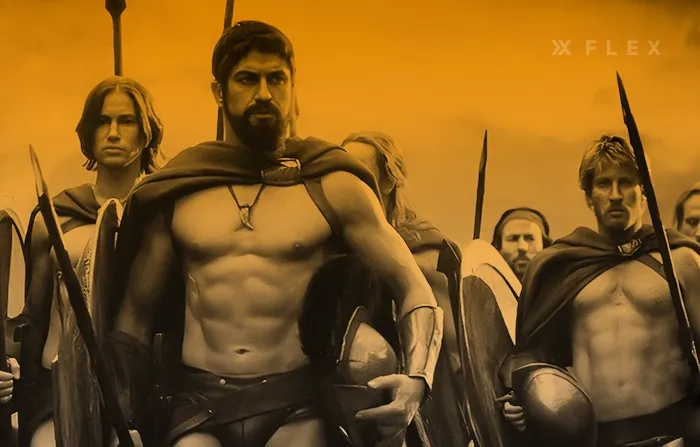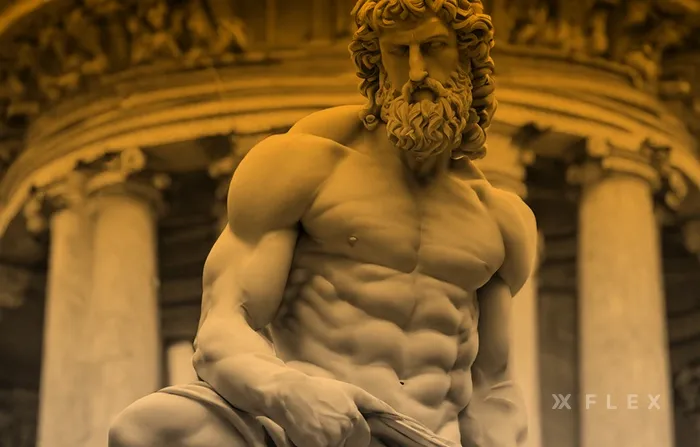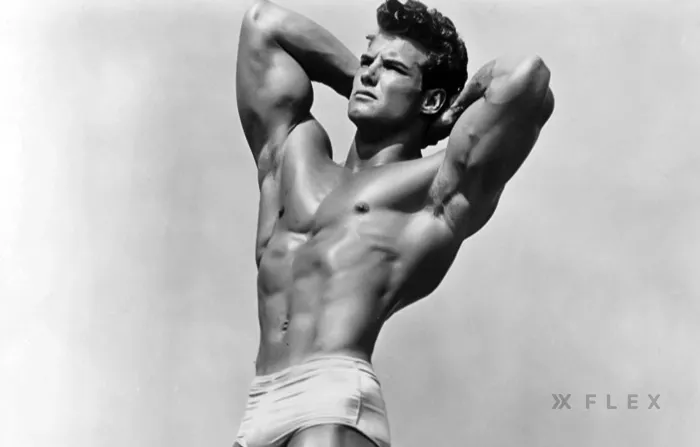Build That Body: Greek God Workout
This is a guide to the Greek God workout. Transform your physique to look more like an ancient hero with these simple body-sculpting moves.
We all have certain visual goals in mind when it comes to working out. We've already covered topics like the Daniel Craig Workout, Spiderman Physique, Aesthetic Workout or Male Gymnast Body.
But what if you could go beyond the mortal? A Greek God workout may help!
Transforming your body into that of a historical Greek god is no easy feat. But if you’re a fan of the movie 300, you’ve probably fantasized once or twice about getting a battle-ready body like the Spartans.
Building your body for aesthetics as well as Herculean strength is no mean feat.
It takes years of dedication and hard work to get the body of a god.
But if you’re up for the challenge, now’s as good a time as ever to get started.
Let’s talk more about traditional Greek fitness aesthetics. Why does the Greek god physique look so good? And can a human can become “mathematically perfect?”

Greek Aesthetics in History
Let’s take a quick journey back to, oh, shall we say 776BC. This is the birth year of the Olympics. Held in honor of the god Zeus, Greek men could compete in Olympic sports every four years whether Greece was at war or not.
The Greek god physique that many men aspire to is influenced by having a balanced and proportionate body figure.
So how were these “ideal proportions” determined?
In ancient Greece, Polykleitos worked as a sculptor from around 450-415 BCE. He is generally considered to be the great mind behind the domain of aesthetics. The concept of summetria or symmetry embodies his theory.
Polykleitos analyzed the specific ratios or measures that a human body had to have between its parts to be considered “beautiful.”
Although most of us now consider beauty and attractiveness subjective concepts, the ancient Greeks sought to attribute measurable definitions to what was considered beautiful or not.
Greeks believed the human body was able to serve as a reflection of the ideals of the gods.
Through hard work and physical fitness, the goal was to transcend the bounds of your own body and become one with the divine.
For example, to follow correct proportions according to ancient Greek ideals, your foot should be one-sixth of the total height of your body. We still often use that standard today. In the West, being six feet tall is considered an admirable height.

Greek God Aesthetics
Achieving the Greek god physique requires a lot of work on the upper body.
In classical Greek culture, the ideal involved a big upper body: strong shoulders and pecs, with a more narrow, tapered waistline.
Although getting shredded abs looks nice, the typical Greek aesthetic focuses on proportions and symmetry.
And there’s a reason for this symmetry too. Legend (myth?) has it that looking hot could even make you more holy. Let’s see how beauty ideals directly correlate to the heavens above.
The Golden Ratio
In ancient Greek aesthetics, civilians and scholars alike thought the golden ratio represented ideal proportions. This ratio was considered the highest ideal of beauty.
What is the golden ratio? Numerically, it breaks down to around 1.618. We see it appearing both in nature and in mathematical concepts.
So how does the golden ratio relate to humans and our bodies? In terms of the human body, the golden ratio was sometimes applied to proportions and measurements.
People believe a body that conformed to these specific proportions would be more harmonious and balanced. This made for better visual harmony and appeal as well. Some scholars and artists, including Polykleitos, were thought to have used the golden ratio in their work to achieve an idealized sense of beauty in the human form.
However, it's important to note that the application of the golden ratio to aesthetics, especially in the context of the human body, is a matter of debate. While some believe it contributes to beauty, others argue that the perception of beauty is subjective and culturally influenced.
In any case, the golden ratio has been a fascinating and enduring concept in the realms of art, architecture, and aesthetics, and its influence can be found in various historical and cultural contexts, including ancient Greece.
Even today, In bodybuilding, many athletes follow the Golden Ratio when it comes to determining what proportions look the best for them.
Bodybuilders in History
Golden-era bodybuilders were known to aspire to these ideal proportions.
Classic bodybuilder Steve Reeves wrote about aiming to achieve similarly strict proportions for beauty in his great bodybuilding book, Building the Classic Physique
According to popular lore, Reeves’ proportions were as follows:
- Height (6' 1")
- Weight (215 lbs)
- Neck (18.5 in)
- Arms (18.5 in)
- Calves (18.5 in)
- Chest (52 in)
- Waist (29 in)
- Thighs (26 in)
It’s hard for us to know if these measurements are perfectly accurate today (some bodybuilding enthusiasts like to embellish). But Reeves measured the size of each body part or muscle in relation to another.
He believed having the same sized neck, arms, and calves made for a man with ideal proportions!

How to Build a Greek God Physique
Known as the birthplace of the Olympics, ancient Greece is certainly a contender for the most athletic bodies in the world.
What is a Greek god's physique? The Greek god's body aesthetic focuses on balanced proportions. It’s visually striking but doesn’t always take equal training for all muscles of the body. Let’s learn more about what this body composition looks like.
Greek God Physique Workout
If you’re looking to go back in time, let’s break down one workout plan you can try to get ripped like the god, let’s test out a basic workout plan you can try.
Upper Body Dominance
A Greek warrior’s physique is upper-body dominant. Think strong biceps, triceps, deltoids, and chest muscles.
Let’s try out an upper body day. Here’s a potential Greek God workout plan if you’re looking to get big on top.
Here's a one-day workout plan to hit your shoulders, chest, and upper body. You can adjust your weight as needed, depending on your fitness level and growth goals.
Start off with 5-10 minutes of light cardio to warm up. Try something like a treadmill walk, either flat or on an incline to increase blood flow and warm up the muscles.
Make sure you target the shoulders directly in your workout as well. Taking a lightweight dumbbell, make big circles with your arms clockwise and counterclockwise.
You can also swing one arm horizontally across the body, similar to a chest fly with your weight to wake the muscles up. Repeat on the other side. Try a vertical movement with your weight as well, like a light shoulder fly.
Repeat these moves freely during your warm-up for 5-10 minutes. Don’t focus too much on “counting reps” here, just get some motion and blood pumping in the body.
Next, let’s hit the weights.
Bench Press:
- 4 sets x 8-10 reps
Overhead Dumbbell Press:
- 3 sets x 10-12 reps
Lateral Raises:
- 3 sets x 12-15 reps
Tricep Dips:
- 3 sets x 10-12 reps
Dumbbell Flys:
- 3 sets x 12-15 reps
Barbell Bicep Curls:
- 3 sets x 10-12 reps
Take some time to rest, stretch, and cool down once you’ve completed this upper-body workout.
Gym Tip: Start slow! If you’re a true beginner, try 3 of these moves to start building up muscle memory and technical understanding of the movement in your body.
Notes:
- Take 60-90 seconds between sets if you’re using reasonably heavy weights. It’s important to focus on proper recovery periods.
- Adjust the weight. Your last 1-2 reps should feel challenging but try to avoid going to failure until you’ve mastered the technique behind the move.
- Watch your form on each exercise to prevent injuries.
- Listen to your body and modify the workout as needed based on your fitness level and any pre-existing conditions.
Remember that muscle growth also requires adequate nutrition and recovery. Eat protein, carbs, and healthy fats in your diet.
Let your muscles recover with proper rest and sleep. Growth takes time so give yourself a good recovery period. Remember to speak to a trainer, doctor, or registered dietitian if you’re starting a new workout program.
Attack Your Back
Ancient Greek warriors are notorious for bulging back muscles.
To continue the Greek God workout program, here are a few simple moves you can try to attack your back.
Deadlifts
- Warm-up: 1 set x 10 reps (light weight)
- Working sets: 4 sets x 6-8 reps
- Deadlifts are an excellent compound movement that targets the entire back, emphasizing the lower back, lats, and traps.
Bent-Over Barbell Rows
- 3 sets x 8-10 reps
- This exercise targets the lats, rhomboids, and middle traps. Focus on keeping your back straight and pulling the barbell towards your lower chest.
Pull-Ups
- 4 sets to failure
- Pull-ups are great for overall back development, targeting the lats and upper back. If bodyweight is too challenging, use an assisted pull-up machine or resistance bands.
Lat Pulldowns
- 3 sets x 10-12 reps
- Lat pulldowns isolate the lats and provide a good pump. Use a wide grip for emphasis on the outer portion of the lats.
Seated Cable Rows
- 3 sets x 10-12 reps
- This exercise targets the mid-back, rhomboids, and traps. Focus on pulling the handle towards your lower chest and squeezing your shoulder blades together.
Gym Tip: Focus on working compound moves that use multiple muscle groups if you’re looking to grow your back (we made it easy for you by working compound activities into this workout!).
Don’t be shy to use more or less weight, depending on your fitness level and desired outcome. Progressively increase your weights as you get stronger.
If you stick with this plan or a similar structure for your back, you should quickly begin to see Greek god gains.
Strong Legs
Sorry leg day skippers. If you’re looking to bulk up like a Greek god, you’re going to have to put a little time in on the squat rack.
Although it’s important to get a good chest pump for the Greek god body, legs matter too.
Let’s get those legs pumping. Here are a few moves to try for your lower half Greek God workout.
Barbell Back Squats
- Warm-up: 1 set x 10 reps (lightweight)
- Working sets: 4 sets x 8-10 reps
- Back squats target the quads, hamstrings, and glutes. Ensure proper form by keeping your back straight, chest up, and squatting to at least parallel.
Romanian Deadlifts
- 3 sets x 10-12 reps
- Romanian deadlifts focus on the hamstrings and glutes. Keep your back straight and hinge at the hips while maintaining a slight bend in the knees.
Lunges
- 3 sets x 12 reps per leg
- Lunges are excellent for targeting the quads, hamstrings, and glutes. Take a step forward, keeping your torso upright, and lower your body until both knees are bent at a 90-degree angle.
Leg Press
- 3 sets x 10-12 reps
- Leg press targets the quads, hamstrings, and glutes. Ensure your knees are aligned with your feet and push through your heels.
Glute Bridges
- 3 sets x 15 reps
- Glute bridges isolate and activate the glutes. Lie on your back with your knees bent, feet flat on the floor, and lift your hips towards the ceiling.
Pro-Tip
Feel free to skip out on the squats if you are doing a leg press or vice versa. Unless you’re feeling super ambitious, these moves work similar muscle groups, so it’s not necessary to do both.
That being said, if you’re new or not comfortable using a barbell for back squats, we suggest the leg press. Leg presses are easier to use for stability. Try the press out until you get more comfortable squatting. And make sure you check out which is the best foot placement for a leg press to max out your low-body work.
Mental Strength
In Greek tradition, mental strength and energy are just as important as physical. Remember, Greek Olympians come from a warrior tradition. To go to war against opposing armies, Greek warriors and gods were just as focused on training their minds!
Take a mindfulness moment after any tough Greek God workout.
Winding down with some yoga, stretching, or meditation can be a great way to make sure your body is not only strong but calm and centered. And for total-body balance, consider moves like the Captain's Chair Workout and Power Tower Workout to have your body looking and feeling on point.
Get your workout to the Greek. Flex AI offers an all-in-one workout platform to help you learn new exercises, visualize your fitness journey, and keep all your PRs in one place.
We’ve made it simple to work on customized fitness plans or to introduce a little friendly competition to your fitness community by sharing exercises with your friends. Start for free through the Flex fitness app.
A true god never skips leg day! For more on building your legs and glutes, read Butt Shapes, Square Butt, and Best Exercises to Build a Heart-Shaped Butt to sculpt a perfect tush.
Related articles


Get fit with Flex
Build muscle & lose weight fast for free.
Available on iPhone + Apple Watch





